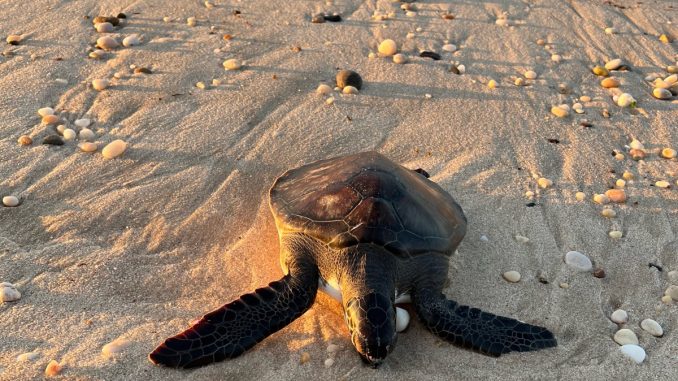
An alarming number of cold-stunned sea turtles are turning up along the coast, with 36 hypothermic sea turtles appearing in shallow areas across Eastern Long Island since mid-November.
“Turtles are missing their cues to head south,” said New York Marine Rescue Center’s program director Maxine Montello. “Over recent years there is less of a transition between summer into winter, which causes marine life to become confused. These sudden shifts to cold weather in the past couple of weeks cause the turtles to become weak and float to the surface, where they are then pushed into the shore by prevailing winds.”
Cold stunning is a hypothermic reaction marine reptiles experience when exposed to prolonged periods in cold water. Most commonly seen in sea turtle populations along the northwest Atlantic, the phenomenon weakens the reptiles until they become inactive. As a result, they can become malnourished, buoyant and critically injured. If not rescued quickly, death is highly probable.
NYMRC, located in Riverhead, notes education as the most important thing when it comes to saving marine wildlife. Classes to train volunteers and beachgoers on how to patrol the beaches are held often. Referred to by NYMRC as “citizen scientists,” the organization said that long-term volunteers participating in the training have made a significant impact on saving turtles.
“Making people aware has also increased the number of reports we get,” said Ms. Montello. “Because more people are out there knowing what to look for, the more turtles are called in. One trained patroller found eight turtles already this season.”
The cold stun season lasts about six to eight weeks, between early November to mid-January. This year’s season started later than usual as the weather remained fairly mild through November. NYMRC notes that stranding sites are usually north-facing beaches experiencing strong north winds, especially at high tide. Upon finding a turtle, report it immediately, even if it appears to already be deceased, experts said. NYMRC encourages people to move the turtle above the high tide line and place dry seaweed over it to protect it from the wind. If unable to stay with the turtle until volunteers arrive, people are asked to provide photos or mark the area with debris.
“Sea turtles are cold-blooded animals, meaning they can’t regulate their body temperature,” said Ms. Montello. “Many of these turtles look deceased but are still alive. It is so important to report a found turtle as soon as possible. The minute we see these animals we have to get them back to our facility.”
The long-term effects of cold stunning are often much greater than the turtles being cold. It takes about four to five days to raise the internal temperature of rescued turtles to a normal state. However, after the turtles are warmed up, they remain in the care of volunteers for six to nine more months. Swimming is introduced and they remain on antibiotics and fluid therapy for several weeks after. Many turtles sustain injuries to their shells and eyes due to being struck by boats while floating on the surface, which can take months to be treated. They must also return to a healthy weight, as the majority of the animals brought in due to cold shock are extremely malnourished.
Success has steadily increased for NYMRC in the more than 25 years since they began operations. Turtles that make it to the center have an 80% to 90% chance of surviving.
“Historically, our highest number was in 2019, when 85 turtles were brought in over the season,” said Ms. Montello. “The trends we are seeing now are similar to that year. Of the 36 found, we have been able to save 15, which is a 42% success rate. We hope this number will increase as the season goes on.”
If you come across a sea turtle during this cold stun season, please immediately call NYMRC’s 24-hour stranding hotline at 631-369-9829.

